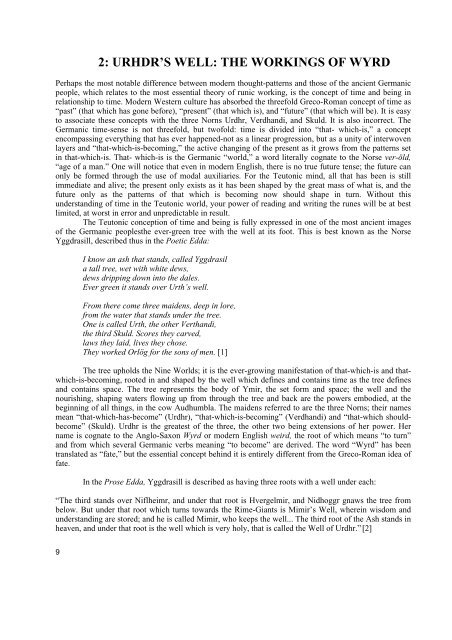TEUTONIC MAGIC - Awaken Video
TEUTONIC MAGIC - Awaken Video
TEUTONIC MAGIC - Awaken Video
You also want an ePaper? Increase the reach of your titles
YUMPU automatically turns print PDFs into web optimized ePapers that Google loves.
2: URHDR’S WELL: THE WORKINGS OF WYRD<br />
Perhaps the most notable difference between modern thought-patterns and those of the ancient Germanic<br />
people, which relates to the most essential theory of runic working, is the concept of time and being in<br />
relationship to time. Modern Western culture has absorbed the threefold Greco-Roman concept of time as<br />
“past” (that which has gone before), “present” (that which is), and “future” (that which will be). It is easy<br />
to associate these concepts with the three Norns Urdhr, Verdhandi, and Skuld. It is also incorrect. The<br />
Germanic time-sense is not threefold, but twofold: time is divided into “that- which-is,” a concept<br />
encompassing everything that has ever happened-not as a linear progression, but as a unity of interwoven<br />
layers and “that-which-is-becoming,” the active changing of the present as it grows from the patterns set<br />
in that-which-is. That- which-is is the Germanic “world,” a word literally cognate to the Norse ver-öld,<br />
“age of a man.” One will notice that even in modern English, there is no true future tense; the future can<br />
only be formed through the use of modal auxiliaries. For the Teutonic mind, all that has been is still<br />
immediate and alive; the present only exists as it has been shaped by the great mass of what is, and the<br />
future only as the patterns of that which is becoming now should shape in turn. Without this<br />
understanding of time in the Teutonic world, your power of reading and writing the runes will be at best<br />
limited, at worst in error and unpredictable in result.<br />
The Teutonic conception of time and being is fully expressed in one of the most ancient images<br />
of the Germanic peoplesthe ever-green tree with the well at its foot. This is best known as the Norse<br />
Yggdrasill, described thus in the Poetic Edda:<br />
I know an ash that stands, called Yggdrasil<br />
a tall tree, wet with white dews,<br />
dews dripping down into the dales.<br />
Ever green it stands over Urth’s well.<br />
From there come three maidens, deep in lore,<br />
from the water that stands under the tree.<br />
One is called Urth, the other Verthandi,<br />
the third Skuld. Scores they carved,<br />
laws they laid, lives they chose.<br />
They worked Orlög for the sons of men. [1]<br />
The tree upholds the Nine Worlds; it is the ever-growing manifestation of that-which-is and thatwhich-is-becoming,<br />
rooted in and shaped by the well which defines and contains time as the tree defines<br />
and contains space. The tree represents the body of Ymir, the set form and space; the well and the<br />
nourishing, shaping waters flowing up from through the tree and back are the powers embodied, at the<br />
beginning of all things, in the cow Audhumbla. The maidens referred to are the three Norns; their names<br />
mean “that-which-has-become” (Urdhr), “that-which-is-becoming” (Verdhandi) and “that-which shouldbecome”<br />
(Skuld). Urdhr is the greatest of the three, the other two being extensions of her power. Her<br />
name is cognate to the Anglo-Saxon Wyrd or modern English weird, the root of which means “to turn”<br />
and from which several Germanic verbs meaning “to become” are derived. The word “Wyrd” has been<br />
translated as “fate,” but the essential concept behind it is entirely different from the Greco-Roman idea of<br />
fate.<br />
In the Prose Edda, Yggdrasill is described as having three roots with a well under each:<br />
“The third stands over Niflheimr, and under that root is Hvergelmir, and Nidhoggr gnaws the tree from<br />
below. But under that root which turns towards the Rime-Giants is Mimir’s Well, wherein wisdom and<br />
understanding are stored; and he is called Mimir, who keeps the well... The third root of the Ash stands in<br />
heaven, and under that root is the well which is very holy, that is called the Well of Urdhr.” [2]<br />
9
















